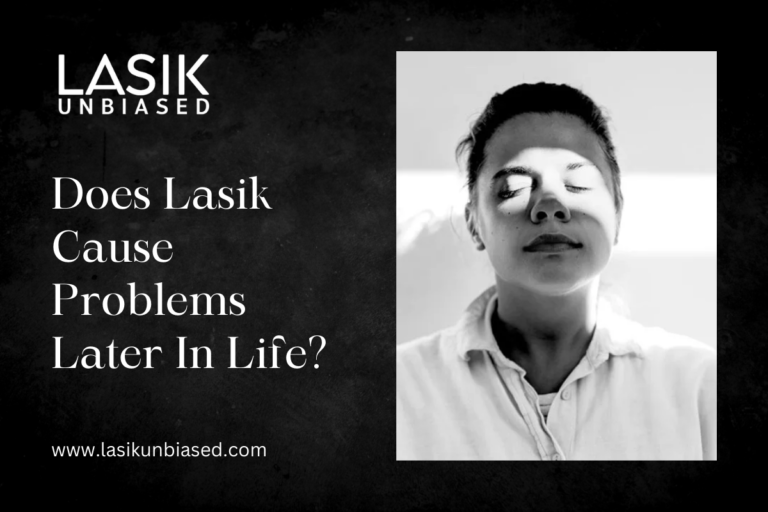LASIK surgery has transformed vision correction by providing a safe and effective alternative to glasses and contact lenses. Millions worldwide have undergone this procedure, achieving clear vision without needing external aids.
While LASIK is highly successful, some wonder whether it may cause problems later in life. Understanding the potential long-term effects of LASIK helps individuals make informed decisions about their eye health.
How LASIK Works and Its Immediate Benefits
LASIK surgery reshapes the cornea using a precise laser to correct refractive errors such as nearsightedness, farsightedness, and astigmatism. By altering the shape of the cornea, light focuses correctly on the retina, resulting in clearer vision. Most patients experience improved eyesight within 24 hours, with minimal discomfort and a quick recovery. The success rate of LASIK is exceptionally high, with most individuals achieving 20/20 vision or better.
Does LASIK Cause Vision Deterioration Over Time?
One of the most common concerns about LASIK is whether it leads to vision deterioration in later years. LASIK permanently reshapes the cornea but does not prevent natural changes in vision that occur with aging. For example, presbyopia, a condition that affects near vision due to aging, can still develop in individuals who have undergone LASIK. This condition usually becomes noticeable after age 40, requiring reading glasses or other corrective measures. However, presbyopia is a natural aging process that LASIK does not cause.
Can LASIK Lead to Dry Eyes in the Future?
Dry eye syndrome is one of the most discussed long-term effects of LASIK. Some patients experience temporary dryness after surgery as the corneal nerves heal. In most cases, this condition resolves within a few months. However, in rare instances, individuals may experience dry eyes for years after the procedure. Proper post-operative care, including artificial tears and omega-3 supplements, helps manage this condition. Modern advancements in LASIK technology have also reduced the likelihood of long-term dry eye issues by using more precise laser techniques that minimize nerve disruption.
Night Vision Changes and Glare Sensitivity
Some LASIK patients report difficulties with night vision, such as halos, glare, or starbursts around lights. These symptoms are more common in the early recovery but usually diminish over time. In rare cases, individuals may experience persistent glare or halos, especially if they had high refractive errors before LASIK. Advancements in laser technology have significantly reduced these risks, ensuring better outcomes for patients with larger pupils or severe prescriptions. Those who still experience night vision issues can explore additional corrective options, such as wavefront-guided LASIK enhancements.
Risk of Corneal Ectasia in the Long Run
Corneal ectasia is a rare but serious complication that can develop years after LASIK. It occurs when the cornea weakens and bulges outward, leading to distorted vision. This condition is similar to keratoconus, a progressive eye disorder that affects the cornea’s shape. Corneal ectasia is more likely to occur in individuals who had thin corneas before surgery or who underwent excessive corneal tissue removal. Modern LASIK screening techniques help identify at-risk patients before surgery, significantly reducing the chances of developing corneal ectasia. For those who do experience this condition, treatment options such as corneal cross-linking and specialized contact lenses can help stabilize vision.
Does LASIK Increase the Risk of Cataracts?
Cataracts are a natural part of aging, causing clouding of the eye’s lens over time. LASIK does not cause cataracts but can slightly affect how cataract surgery is performed later in life. Because LASIK changes the corneal curvature, doctors must take extra care when calculating the power of the intraocular lens (IOL) used during cataract surgery. With advancements in diagnostic technology, eye surgeons can accurately determine the appropriate IOL strength, ensuring optimal vision correction for patients who have had LASIK in the past.
Impact on Future Eye Surgeries
Individuals who have undergone LASIK can still receive other eye surgeries, including cataract removal or retinal treatments. However, since LASIK alters corneal thickness and shape, surgeons must consider these factors when planning future procedures. Providing a detailed medical history to eye specialists ensures that any future surgeries are tailored to the patient’s specific needs.
The Role of Age-Related Changes in Vision
Aging affects vision regardless of whether an individual has had LASIK. Conditions such as presbyopia, macular degeneration, and glaucoma can still develop over time. LASIK does not increase the risk of these conditions but does not prevent them. Regular eye exams remain essential for maintaining overall eye health and addressing age-related changes as they arise.
LASIK Enhancements and Touch-Ups
While most patients achieve permanent vision correction after LASIK, some may experience minor vision changes years later. In some cases, a LASIK enhancement procedure can refine vision if necessary. Enhancements are generally safe and effective but depend on corneal thickness and overall eye health. Regular check-ups with an eye specialist ensure that any vision changes are detected early and treated appropriately.
Preventing Long-Term Complications After LASIK
Proper eye care practices are crucial to maintaining healthy vision after LASIK. Protecting the eyes from excessive UV exposure, staying hydrated, and maintaining a balanced diet rich in eye-supporting nutrients help preserve vision quality. Routine eye exams help detect changes early, allowing for timely intervention.
Weighing the Benefits and Risks
LASIK has provided millions of people with lasting vision improvement, reducing dependence on glasses and contact lenses. While some long-term effects may occur, they are rare and often manageable with proper care. Most LASIK patients enjoy clear vision for decades without experiencing significant complications. The key to a successful outcome is thorough pre-surgical screening, adherence to post-operative care, and regular eye health monitoring.
LASIK is a highly effective and well-established vision correction procedure with long-term benefits for most patients. While some individuals may experience minor side effects, serious complications are rare. The natural aging process still affects vision over time, but LASIK does not accelerate or worsen these changes.
By choosing an experienced surgeon, following proper post-operative care, and maintaining regular eye check-ups, individuals can enjoy the benefits of LASIK without worrying about significant problems later in life.


